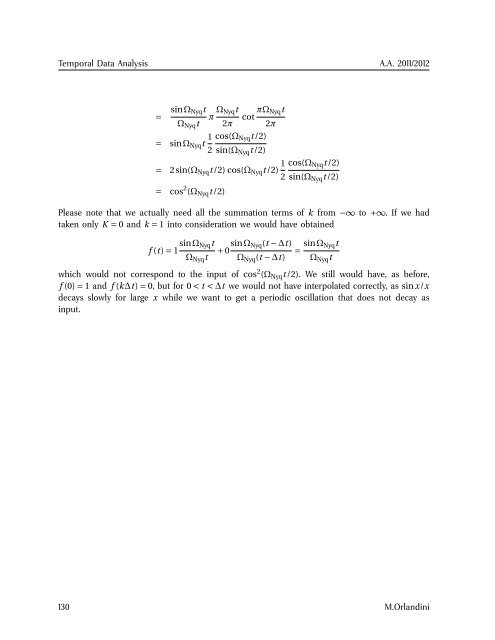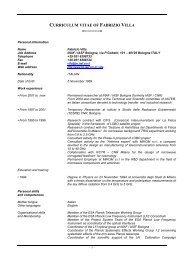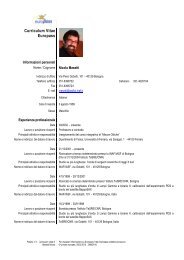- Page 1 and 2:
Temporal Data Analysis: Theory and
- Page 3 and 4:
Course Outline Table of Contents Li
- Page 5 and 6:
A.A. 2011/2012 Temporal Data Analys
- Page 7 and 8:
List of Figures 1.1 Classification
- Page 9 and 10:
List of Definitions 2.1 Even and od
- Page 11 and 12:
List of Theorems 2.1 Convolution th
- Page 13:
Part I Theory 1
- Page 16 and 17:
Temporal Data Analysis A.A. 2011/20
- Page 18 and 19:
Temporal Data Analysis A.A. 2011/20
- Page 20 and 21:
Temporal Data Analysis A.A. 2011/20
- Page 22 and 23:
Temporal Data Analysis A.A. 2011/20
- Page 24 and 25:
Temporal Data Analysis A.A. 2011/20
- Page 26 and 27:
Temporal Data Analysis A.A. 2011/20
- Page 28 and 29:
Temporal Data Analysis A.A. 2011/20
- Page 30 and 31:
Temporal Data Analysis A.A. 2011/20
- Page 32 and 33:
Temporal Data Analysis A.A. 2011/20
- Page 34 and 35:
Temporal Data Analysis A.A. 2011/20
- Page 36 and 37:
Temporal Data Analysis A.A. 2011/20
- Page 38 and 39:
Temporal Data Analysis A.A. 2011/20
- Page 40 and 41:
Temporal Data Analysis A.A. 2011/20
- Page 42 and 43:
Temporal Data Analysis A.A. 2011/20
- Page 44 and 45:
Temporal Data Analysis A.A. 2011/20
- Page 46 and 47:
Temporal Data Analysis A.A. 2011/20
- Page 48 and 49:
Temporal Data Analysis A.A. 2011/20
- Page 50 and 51:
Temporal Data Analysis A.A. 2011/20
- Page 52 and 53:
Temporal Data Analysis A.A. 2011/20
- Page 54 and 55:
Temporal Data Analysis A.A. 2011/20
- Page 56 and 57:
Temporal Data Analysis A.A. 2011/20
- Page 58 and 59:
Temporal Data Analysis A.A. 2011/20
- Page 60 and 61:
Temporal Data Analysis A.A. 2011/20
- Page 62 and 63:
Temporal Data Analysis A.A. 2011/20
- Page 64 and 65:
Temporal Data Analysis A.A. 2011/20
- Page 66 and 67:
Temporal Data Analysis A.A. 2011/20
- Page 68 and 69:
Temporal Data Analysis A.A. 2011/20
- Page 70 and 71:
Temporal Data Analysis A.A. 2011/20
- Page 72 and 73:
Temporal Data Analysis A.A. 2011/20
- Page 74 and 75:
Temporal Data Analysis A.A. 2011/20
- Page 76 and 77:
Temporal Data Analysis A.A. 2011/20
- Page 78 and 79:
Temporal Data Analysis A.A. 2011/20
- Page 80 and 81:
Temporal Data Analysis A.A. 2011/20
- Page 83 and 84:
Chapter5 Procedures for Analyzing R
- Page 85 and 86:
A.A. 2011/2012 Temporal Data Analys
- Page 87 and 88:
A.A. 2011/2012 Temporal Data Analys
- Page 89 and 90:
A.A. 2011/2012 Temporal Data Analys
- Page 91 and 92: Chapter6 Temporal Analysis in X-ray
- Page 93 and 94: A.A. 2011/2012 Temporal Data Analys
- Page 95 and 96: A.A. 2011/2012 Temporal Data Analys
- Page 97 and 98: A.A. 2011/2012 Temporal Data Analys
- Page 99 and 100: A.A. 2011/2012 Temporal Data Analys
- Page 101 and 102: A.A. 2011/2012 Temporal Data Analys
- Page 103 and 104: A.A. 2011/2012 Temporal Data Analys
- Page 105 and 106: A.A. 2011/2012 Temporal Data Analys
- Page 107 and 108: A.A. 2011/2012 Temporal Data Analys
- Page 109 and 110: A.A. 2011/2012 Temporal Data Analys
- Page 111 and 112: A.A. 2011/2012 Temporal Data Analys
- Page 113 and 114: A.A. 2011/2012 Temporal Data Analys
- Page 115 and 116: A.A. 2011/2012 Temporal Data Analys
- Page 117 and 118: A.A. 2011/2012 Temporal Data Analys
- Page 119 and 120: A.A. 2011/2012 Temporal Data Analys
- Page 121 and 122: Chapter7 Bibliography Reference Tex
- Page 123 and 124: AppendixA Examples Shown at the Bla
- Page 125 and 126: A.A. 2011/2012 Temporal Data Analys
- Page 127 and 128: A.A. 2011/2012 Temporal Data Analys
- Page 129 and 130: A.A. 2011/2012 Temporal Data Analys
- Page 131 and 132: A.A. 2011/2012 Temporal Data Analys
- Page 133 and 134: A.A. 2011/2012 Temporal Data Analys
- Page 135 and 136: A.A. 2011/2012 Temporal Data Analys
- Page 137 and 138: A.A. 2011/2012 Temporal Data Analys
- Page 139 and 140: A.A. 2011/2012 Temporal Data Analys
- Page 141: A.A. 2011/2012 Temporal Data Analys
- Page 145 and 146: AppendixB Practical Session on Timi
- Page 147 and 148: A.A. 2011/2012 Temporal Data Analys
- Page 149 and 150: A.A. 2011/2012 Temporal Data Analys
- Page 151 and 152: A.A. 2011/2012 Temporal Data Analys
- Page 153 and 154: A.A. 2011/2012 Temporal Data Analys
- Page 155 and 156: A.A. 2011/2012 Temporal Data Analys
- Page 157 and 158: A.A. 2011/2012 Temporal Data Analys
- Page 159 and 160: A.A. 2011/2012 Temporal Data Analys
- Page 161 and 162: A.A. 2011/2012 Temporal Data Analys
- Page 163 and 164: A.A. 2011/2012 Temporal Data Analys
- Page 165 and 166: A.A. 2011/2012 Temporal Data Analys
- Page 167 and 168: A.A. 2011/2012 Temporal Data Analys
- Page 169 and 170: A.A. 2011/2012 Temporal Data Analys
- Page 171 and 172: A.A. 2011/2012 Temporal Data Analys
- Page 173 and 174: A.A. 2011/2012 Temporal Data Analys
- Page 175 and 176: A.A. 2011/2012 Temporal Data Analys
- Page 177 and 178: A.A. 2011/2012 Temporal Data Analys
- Page 179: A.A. 2011/2012 Temporal Data Analys

















